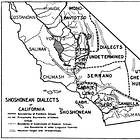As a historian, I often use open-source books that are considered outdated by some. Even with such criticisms, I still do enjoy these books for the value they bring. I believe there are several benefits to this—here are two:
First, many of these books, like the one used to compose this article, are much closer in the timeline of these cultures, where some of these details may have fallen through the cracks.
Second, these books are academic studies (mainly by the University of California, Berkeley) that are very detailed.
One of the primary problems with books like these is the volume (they are hundreds of pages), and the need to sift through erroneous statements. I have done my best to focus on specific topics, highlighting scholarly discoveries, and I hope to repurpose some of this valuable work for free use by communities and students seeking more information about their heritage, whether by blood or regional settlement.
Why take this approach? I have focused my entire catalog on writing the anecdotes and biographies of people in the past. Nobody can do it all, a realization I had more than a decade ago. There's a lot of context that can enhance my work. This is just one example of groups like the Luiseño that are reduced down to a simple narrative, and in the process, stripping context. In the loss of that context, I discovered, as a historian, that they lose their cultural industriousness, their cultural strengths, and their adaptability as a people. I refuse to write historical anecdotes and biographies without proper context for the narratives presented.
Much of this work has already been done. This first chapter comes from the work of Philip Stedman Sparkman, titled “Foods of the Luiseño,” who lived in Rincon, California, among many Luiseño Indians. He worked as a shopkeeper until he was murdered in 1907 by Francisco Calac, a crazed man who was deemed unfit for trial. You can read more of this in “The English Storekeeper at Rincon.”
Who are the Luiseño?
The Luiseños, of the Shoshonean linguistic family, shared deep ancestral connections with neighboring Cahuilla to the east, as well as distant kin like the Bannocks of the northern interior, Utes, Paiutes, Comanches, and Mokis. Within their ranks, groups such as the Saboba and Temescal peoples coexisted, though the Saboba spoke a distinct dialect, marking subtle cultural divergences.
Their territory stretched along California’s coastal edge, from the brackish estuaries of Agua Hedionda Creek to the rugged promontories near Point Duma, positioning them as the southwesternmost extension of this vast linguistic lineage in the lands that would later form the United States. Anchored in a coastal ecology of tidal ebbs and fertile valleys, the Luiseños crafted a lifeway shaped by the region’s abundance and its growing contestation.
Their world was one of named places, resonant with meaning: Temeku (Temecula), Pakhavkha (Temescal Creek), Paiakhehe (Lake Elsinore), and Wiawio (Oceanside). These toponyms, rooted in the Luiseño language and experience, mapped a landscape of cultural and ecological significance. Their first recorded encounter with Europeans likely came in 1542, when Juan Rodríguez Cabrillo’s expedition brushed against their shores, inaugurating a long arc of contact and disruption.
The Luiseños inhabited a region—a kind of Indigenous county—where distinct tribal groups, including the Gabrielino, Juaneño (with their divergent tongue), and the Diegueño of the Yuman linguistic family to the south, navigated varied ecological and economic niches. The name “Luiseño,” like those of their neighbors, was tethered to the Spanish mission system, specifically the Mission San Luis Rey, founded in 1798 near present-day Oceanside.
The San Luis Rey River, baptized “Río San Luis Rey de Francia” by Franciscan friars in homage to St. Louis, King of France, served as a vital artery through this contested terrain. Four miles from its ocean outlet, the mission emerged as a nexus of spiritual zeal and colonial ambition. By 1816, the outpost of Pala, twenty miles upstream, extended this reach, drawing Native peoples into its orbit.
Those gathered under the mission’s shadow, reshaped by Franciscan labor demands and religious doctrines, were labeled “San Luiseños” by their overseers—a name that encapsulated both the imposition of colonial order and the persistent resilience of Indigenous life amid transformative pressures.
External Resources
Kroeber, Alfred Louis. The Washo Language of East Central California and Nevada. Berkeley: University of California Press, 1907.
Native Land Digital. "Luiseño." Native-Land.ca. Accessed August 20, 2025. https://native-land.ca/listings/territories/luiseno.
Sparkman, Philip Stedman. The Culture of the Luiseño Indians. Berkeley, California: The University Press, 1908.






